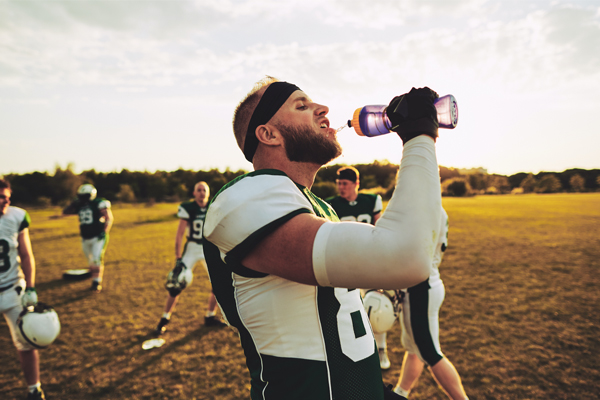
The Arizona desert is no joke, especially during the summertime. Phoenix has shown record high temperatures of 112°F during the summer, right at the beginning of football season. Making sure to play outdoors is extremely important to avoid serious accidents due to the heat.
Here are the top three injuries that individuals can suffer from when playing in the heat:
- Heat Cramps: a less severe condition associated with excessive play. Heat cramps are painful and involuntary muscle spasms that can occur during heavy exercise in the heat. Symptoms of heat cramps include heavy sweating, fatigue, thirst, and intense muscle pain. Physical activity should stop until the cramps go away.
- Heat Exhaustion:a condition associated with heavy sweating, cold and clammy skin, rapid and weak pulse, muscle cramps, weakness, dizziness, nausea, and headache. To help alleviate these symptoms, move the individual to a cooler place, provide them with lots of fluids, and place cool, wet cloths on their body. Typically these symptoms will lessen if these actions are taken, but if not medical attention should be sought out.
- Heat Stroke:the most dangerous outcome of playing in extreme heat. A heat stroke occurs when your internal body temperature reaches 103°F or higher. It is associated with symptoms including a throbbing headache, rapid and strong pulse, lack of sweat, confusion, nausea, and red hot skin. Immediate action should be taken if these symptoms are observed such as calling 911, moving the individual to a cool place, and not administering them fluids.
Staying hydrated will help to avoid these dangerous conditions during your summer sports pre-season such as football, soccer, or lacrosse practices. Follow these tips to stay hydrated before, during and after play or practice:
- Pre-hydrate before your outdoor workout by drinking 17-20 ounces of water 2-3 hours before you play.
- Never wait until you’re thirsty to drink water.
- Drink healthy electrolytes such as coconut water, fruit juices, and sugar-free sports drinks.
- Drink cool but not ice-cold water to avoid constricting your stomach, allowing for more fluid absorption.
- Monitor urine color to know your state of hydration. Dark yellow urine can be a sign of dehydration.
- Avoid food and drinks that will dehydrate you such as alcohol, caffeinated drinks, and excessive salty foods.
It is so important to monitor your body and respond adequately to the symptoms you display during outdoor physical activity in the desert heat. Hydration is the best way to avoid any of the conditions previously mentioned so remember to always hydrate!
Author:
Dr. Anup Shah is a board-certified, fellowship-trained sports medicine orthopaedic surgeon specializing in Knee and Shoulder Surgery in Phoenix, Arizona at Banner Health. Dr. Shah uses a patient-centric and an evidence-based approach to help his patients achieve their desired goals.









